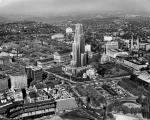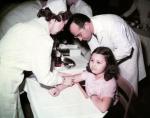![header=[Marker Text] body=[First institution of higher education west of the Alleghenies and north of the Ohio River. Founded in 1787 as the Pittsburgh Academy, it became the Western University of Pennsylvania in 1819. Present name was adopted in 1908.] sign](kora/files/1/10/1-A-36F-139-ExplorePAHistory-a0m0n2-a_450.jpg)
Mouse over for marker text
Name:
University of Pittsburgh
Region:
Pittsburgh Region
County:
Allegheny
Marker Location:
SE corner, 5th Ave. and Bigelow Blvd., Oakland, Pittsburgh
Dedication Date:
November 2, 1979
Behind the Marker
"Cultivated genius has the force of electric fire," Hugh Henry Brackenridge wrote anonymously in the September 1786 issue of the Pittsburgh Gazette. Acting on the prompt, within the year local citizens with strong ties to the local Presbyterian congregation organized what became the Pittsburgh Academy, forerunner of the University of Pittsburgh.
Little is known of the Pittsburgh Academy, except that it reflected a deep desire for a formal seat of learning in the Three Rivers area. Incorporated in 1787, the school had a simple log cabin structure typical of frontier schools established throughout western Pennsylvania after the American Revolution. In time, a new building was erected in downtown Pittsburgh. Mathematics, English, classical languages, Philosophy, and Geography were the bedrock of the curriculum for those students able to pay the meager tuition. The greater turning in institutional development came in the 1819 when trustees petitioned and received a charter for the private and nonsectarian University of Western Pennsylvania.
Like many of Pennsylvania's several dozen private colleges chartered in the half-century after the Revolution, the University of Western Pennsylvania struggled through difficult financial circumstances. Low enrollments, the uncertain economic cycle of boom and bust, and at least two horrific fires in the 1840s forced several temporary closures prior to the Civil War. The post-war years witnessed a renaissance of sorts as the coming Industrial Revolution to western Pennsylvania, but as late as 1884 the institution boasted only eighteen instructors and barely more than fifty students. Not unlike other private colleges in Pittsburgh, close alliances to wealthy industrialists helped enlarge the school's resources and its reputation as a center for learning in industrial Pennsylvania. The astronomical observatory directed by S.P. Langley was among the most widely heralded academic programs of its kind at the end of the nineteenth century.
astronomical observatory directed by S.P. Langley was among the most widely heralded academic programs of its kind at the end of the nineteenth century.
A 1908 name change to the University of Pittsburgh sealed the institution's local and regional identity. The next year students and trustees embraced the Panther as the new school mascot. Over the next several decades a wide-ranging liberal-arts curriculum anchored more specialized studies medicine, law, music and the sciences. Strong ties to the local business community provided resources for cutting edge research in industrial design and a new school of business. With the move of the residential campus to the neighborhood of Oakland and the erection of the 42-story Cathedral of Learning, now the second tallest education building in the world, the University of Pittsburgh's place as a citadel of refined learning and culture seemed assured.
Perhaps the most remarkable period of growth and innovation came after World War II, when the University of Pittsburgh emerged as one of the great national research universities in America. Like Penn State and Temple University, the University of Pittsburgh was a "state-related" institution, meaning it received annual state appropriations but enjoyed a considerable degree of autonomy.
Penn State and Temple University, the University of Pittsburgh was a "state-related" institution, meaning it received annual state appropriations but enjoyed a considerable degree of autonomy.
In partnership with civic and corporate officials the University expanded post-baccalaureate and professional studies, hired new faculty, and placed an added premium on research and development that served social and business needs. In the 1950s, Jonas Salk and other university researchers perfected the first polio vaccine in the Virus Research Lab on campus. In virtually every category of analysis, from the number of new corporate start-ups to biotechnology and bioterrorism research, the University of Pittsburgh continues to excel in this new paradigm.
With four branch campuses across western Pennsylvania, the university has used its regional affiliations to build a national reputation for excellence. With over 40,000 employees, the university remains the largest employer in the region. Panther intercollegiate athletic programs are prominent as well, with a dozen national championships in football, basketball, and other competitive Division One sports. Student traditions include sliding onto the former home plate from Forbes Field, where the Pittsburgh Pirates once played; now on display inside a university building, the plate is said to bring good luck on midterm and final exams.
Forbes Field, where the Pittsburgh Pirates once played; now on display inside a university building, the plate is said to bring good luck on midterm and final exams.
With more than 30,000 undergraduate and graduate students, the University of Pittsburgh has evolved from modest beginnings in a log cabin near the banks of the river into the prototypical national research university.
Little is known of the Pittsburgh Academy, except that it reflected a deep desire for a formal seat of learning in the Three Rivers area. Incorporated in 1787, the school had a simple log cabin structure typical of frontier schools established throughout western Pennsylvania after the American Revolution. In time, a new building was erected in downtown Pittsburgh. Mathematics, English, classical languages, Philosophy, and Geography were the bedrock of the curriculum for those students able to pay the meager tuition. The greater turning in institutional development came in the 1819 when trustees petitioned and received a charter for the private and nonsectarian University of Western Pennsylvania.
Like many of Pennsylvania's several dozen private colleges chartered in the half-century after the Revolution, the University of Western Pennsylvania struggled through difficult financial circumstances. Low enrollments, the uncertain economic cycle of boom and bust, and at least two horrific fires in the 1840s forced several temporary closures prior to the Civil War. The post-war years witnessed a renaissance of sorts as the coming Industrial Revolution to western Pennsylvania, but as late as 1884 the institution boasted only eighteen instructors and barely more than fifty students. Not unlike other private colleges in Pittsburgh, close alliances to wealthy industrialists helped enlarge the school's resources and its reputation as a center for learning in industrial Pennsylvania. The
A 1908 name change to the University of Pittsburgh sealed the institution's local and regional identity. The next year students and trustees embraced the Panther as the new school mascot. Over the next several decades a wide-ranging liberal-arts curriculum anchored more specialized studies medicine, law, music and the sciences. Strong ties to the local business community provided resources for cutting edge research in industrial design and a new school of business. With the move of the residential campus to the neighborhood of Oakland and the erection of the 42-story Cathedral of Learning, now the second tallest education building in the world, the University of Pittsburgh's place as a citadel of refined learning and culture seemed assured.
Perhaps the most remarkable period of growth and innovation came after World War II, when the University of Pittsburgh emerged as one of the great national research universities in America. Like
In partnership with civic and corporate officials the University expanded post-baccalaureate and professional studies, hired new faculty, and placed an added premium on research and development that served social and business needs. In the 1950s, Jonas Salk and other university researchers perfected the first polio vaccine in the Virus Research Lab on campus. In virtually every category of analysis, from the number of new corporate start-ups to biotechnology and bioterrorism research, the University of Pittsburgh continues to excel in this new paradigm.
With four branch campuses across western Pennsylvania, the university has used its regional affiliations to build a national reputation for excellence. With over 40,000 employees, the university remains the largest employer in the region. Panther intercollegiate athletic programs are prominent as well, with a dozen national championships in football, basketball, and other competitive Division One sports. Student traditions include sliding onto the former home plate from
With more than 30,000 undergraduate and graduate students, the University of Pittsburgh has evolved from modest beginnings in a log cabin near the banks of the river into the prototypical national research university.
Beyond the Marker








